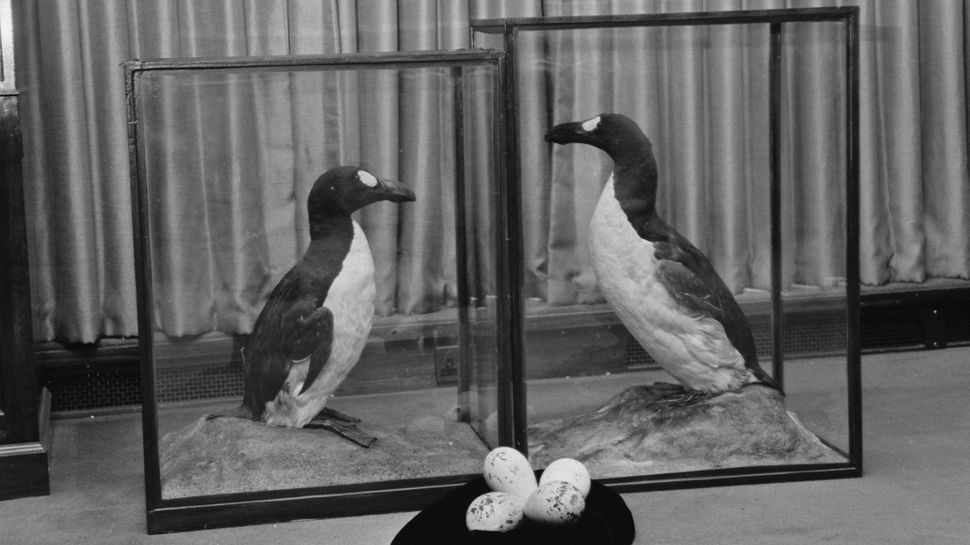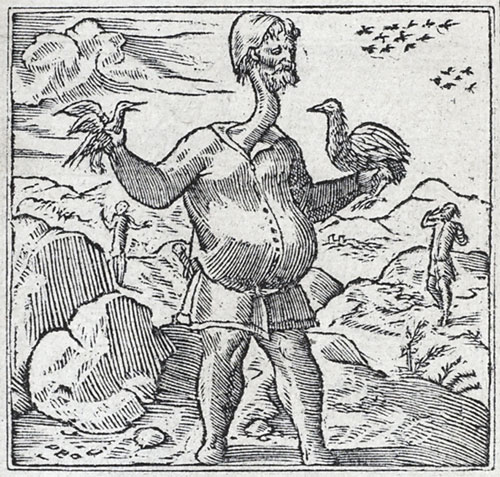Environment & Energy
Related: About this forum'It was clearly a human assault on the species': The fate of the great auk
By Alexander McNamara
published 1 hour ago
Author and professor Gísli Pálsson details the final years of the North Atlantic flightless birds that were driven to extinction by humans — an event that caused a moment of realization about humanity's destructive powers.

black and white photo showing two great auks in museum display cabinets with eggs placed on a black cushion
Two preserved great auk specimens displayed at a museum in 1971. The last pair of great auks were killed in 1844. (Image credit: Evening Standard/Getty Images)
Great auks (Pinguinus impennis) were large flightless birds that thrived on rocky islands in the North Atlantic for thousands of years. However, humans hunted them to extinction within just a few hundred years, targeting the auks for their feathers, fat, meat and oil. The last breeding pair was killed by a fisher off the coast of Iceland in 1844, and the last sighting — of a single male, and potentially the last of its species — was off the Newfoundland Banks in 1852.
Alexander McNamara: What is a great auk, and what happened to it?
Gísli Pálsson: The great auk was a tall bird — 80 centimeters [31 inches] and quite thick with lots of meat — and it was flightless so would nest on skerries [small rocky islands] where it could climb up. [It lived] In various spots along the North Atlantic and in North America, and humans exploited it for millennia — the oldest images we have [are] from a cave in France, close to Marseille from 27,000 years ago. The biggest colony was probably in Newfoundland and Indigenous groups in North America hunted it for quite a long time. We have early anthropological reports and archaeological evidence, but this was largely for religious events, and symbolism, [for example] the Beothuk [Indigenous people] captured eggs and used them in rituals.
The great auk was hunted in the Scottish Isles, Norway, Iceland and some other places — but the major slaughterhouse of the great auks was in Newfoundland. It was European sailors, French and Portuguese, in the 16th and 17th centuries. They would hunt great auks in their thousands, decimating the local stock. At the same time, they would kill the Beothuk, and so this was genocide plus near extinction of the great auks. The European sailors were there to catch fish, but they needed food on the way back, so would fill their boats with great auk, salt the meat and sail on to Europe. Some of my colleagues have [said] this was the first fast food stop in the world.
In his new book, "The Last of Its Kind: The Search for the Great Auk and the Discovery of Extinction" (Princeton University Press, 2024), anthropologist Gísli Pálsson recounts the final years of the great auk, using accounts and interviews from Victorian ornithologists John Wolley and Alfred Newton, who realized that species extinction was not something confined to the past but a tangible process that humans can cause.
In an interview with Live Science, Pálsson discusses the background to the book, the lasting legacy of the great auks' demise and whether the species could or should be resurrected.
More:
https://www.livescience.com/animals/extinct-species/it-was-clearly-a-human-assault-on-the-species-the-fate-of-the-great-auk

What else can I eat?????
muriel_volestrangler
(102,283 posts)...
The sailors watched as the bird, a Great Auk, waddled clumsily along. Agile in the water, the unusual creature was defenseless against humans on land, and its ineptitude made it an easy target “Prophet-like that lone one stood,” one of the men later said of the encounter.
Perhaps the men enjoyed the thrill of the hunt, or perhaps they realized its meat and feathers were incredibly valuable. In any case, they abducted the bird, tying its legs together and taking it back to their ship. For three days, the sailors kept the Great Auk alive, but on the fourth, during a terrible storm, the sailors grew fearful and superstitious. Condemning it as “a maelstrom-conjuring witch,” they stoned it to death.
It was the last of its kind to ever be seen on the British Isles. Four years later, the Great Auk vanished from the world entirely when fishermen hunted down the last pair on the shores of Eldey Island, off the coast of Iceland. The men spotted the mates in the distance and attacked, catching and killing the birds as they fled for safety. The female had been incubating an egg, but in the race to catch the adults, one of the fishermen crushed it with his boot, stamping out the species for good.
https://www.smithsonianmag.com/smithsonian-institution/with-crush-fisherman-boot-the-last-great-auks-died-180951982/
hatrack
(60,535 posts)Imagine a manatee, but up to 30 feet long and weighing up to 11 tons.
Steller's sea cow (Hydrodamalis gigas) is an extinct sirenian described by Georg Wilhelm Steller in 1741. At that time, it was found only around the Commander Islands in the Bering Sea between Alaska and Russia; its range extended across the North Pacific during the Pleistocene epoch, and likely contracted to such an extreme degree due to the glacial cycle. It is possible indigenous populations interacted with the animal before Europeans. Steller first encountered it on Vitus Bering's Great Northern Expedition when the crew became shipwrecked on Bering Island. Much of what is known about its behavior comes from Steller's observations on the island, documented in his posthumous publication On the Beasts of the Sea. Within 27 years of its discovery by Europeans, the slow-moving and easily-caught mammal was hunted into extinction for its meat, fat, and hide.
Some 18th-century adults would have reached weights of 8–10 t (8.8–11.0 short tons) and lengths up to 9 m (30 ft). It was a member of the family Dugongidae, of which the 3 m (9.8 ft) long dugong (Dugong dugon) is the sole living member. It had a thicker layer of blubber than other members of the order, an adaptation to the cold waters of its environment. Its tail was forked, like that of whales or dugongs. Lacking true teeth, it had an array of white bristles on its upper lip and two keratinous plates within its mouth for chewing. It fed mainly on kelp, and communicated with sighs and snorting sounds. Steller believed it was a monogamous and social animal living in small family groups and raising its young, similar to modern sirenians.
EDIT
https://en.wikipedia.org/wiki/Steller%27s_sea_cow
